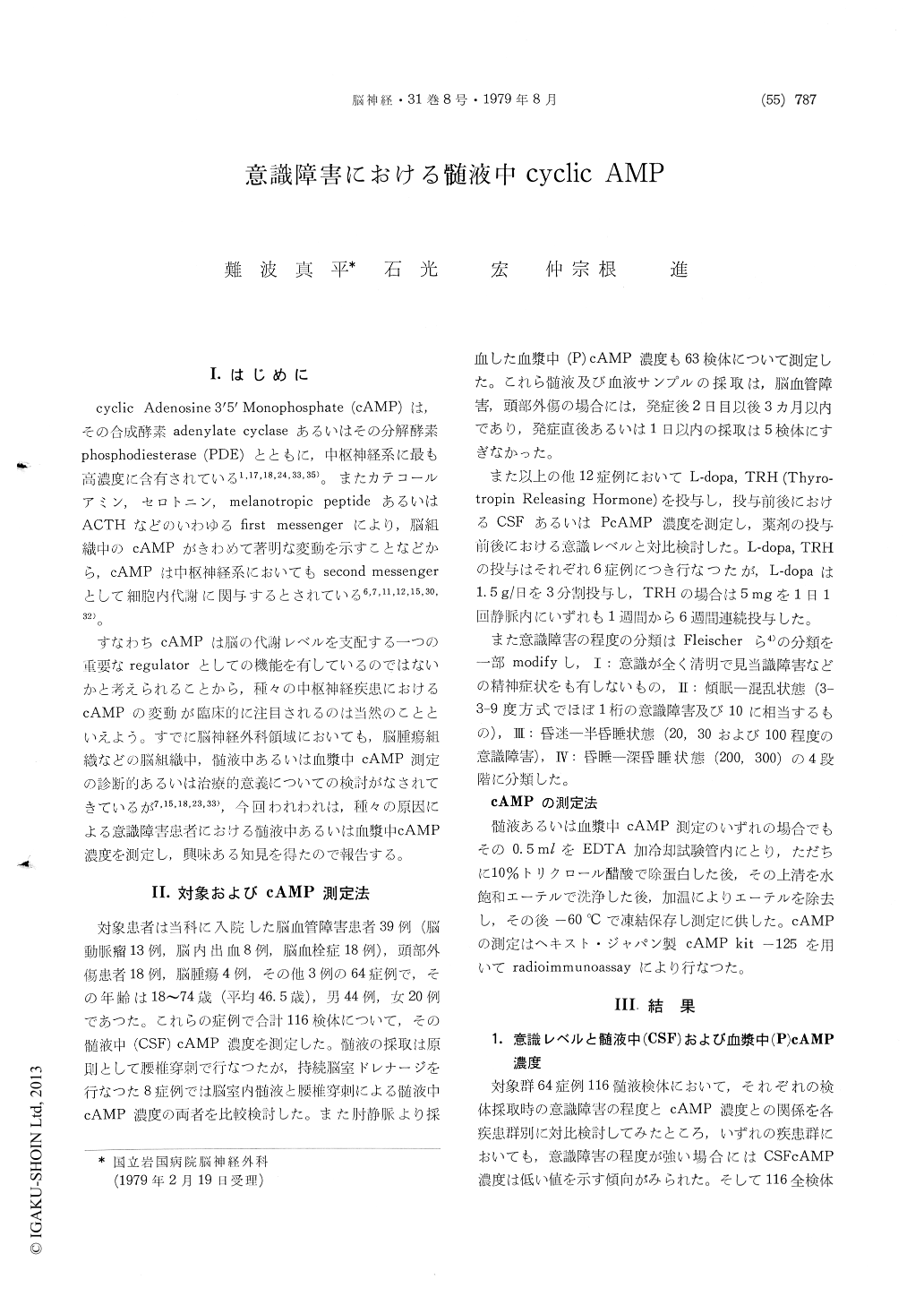Japanese
English
- 有料閲覧
- Abstract 文献概要
- 1ページ目 Look Inside
I.はじめに
cyclic Adenosine 3´5´Monophosphate (cAMP)は,その合成酵素adenylate cyclaseあるいはその分解酵素phosphodiesterase (PDE)とともに,中枢神経系に最も高濃度に合有されている1,17,18,24,33,35)。またカテコールアミン,セロトニン,melanotropic peptideあるいはACTHなどのいわゆるfirst messengerにより,脳組織中のcAMPがきわめて著明な変動を示すことなどから,cAMPは中枢神経系においてもsecond messengerとして細胞内代謝に関与するとされている6,7,11,12,15,30,32)。
すなわちcAMPは脳の代謝レベルを支配する一つの重要なregulatorとしての機能を有しているのではないかと考えられることから,種々の中枢神経疾患におけるcAMPの変動が臨床的に注目されるのは当然のことといえよう。すでに脳神経外科領域においても,脳腫瘍組織などの脳組織中,髄液中あるいは血漿中cAMP測定の診断的あるいは治療的意義についての検討がなされてきているが7,15,18,23,33),今回われわれは,種々の原因による意識障害患者における髄液中あるいは血漿中cAMP濃度を測定し,興味ある知見を得たので報告する。
The concentrations of 3´5´ cyclic adenosine monophosphate (cAMP) in lumbar cerebrospinal fluid and in plasma of 64 patients were measured, and it was investigated whether there was any correlation between the cAMP concentration and the level of consciousness. Of the patients investi-gated, 39 were following cerebrovascular accidents, 18 were head injuries, 4 out of the other 7 patients had previously operated brain tumors (44 males, 20 females: age, 18-74 with mean of 46.5 years old). Grades of consciousness disturbance was as from I to IV, I: no disturbance of consciousness at all, II: drowsy~confusion III: stupor~semicoma IV: coma~deep coma. From these patients 116 CSF and 63 plasma samples were taken and cAMP concentrations were determined by radioimmuno-assay. In twelve other patients, L-dopa or TRH (thyrotropin releasing hormone) was administered, and levels of consciousness and cAMP concentrations were observed before and after the administration.
(I) Concentrations of CSF cAMP were signifi-cantly lower in the patients with consciousness disturbance than in the normal consciousness, especially extremely low concentration in the coma and deep coma (grade I: 46. 0±13.8, II: 34.8± 11.7, III: 23. 1+7.0, IV: 3.6±1.7 pmol/ml). On the contrary, no significant depression of plasma cAMP values were detected even in the coma patients.
(II) Concentrations of CSF cAMP were increased following initial values around 20 pmol/ml as the consciousness improved. Lower than 5 pmol/ml of CSF cAMP concentrations continued without any increase until death in the patients with extremely deteriorated consciousness.
(III) Values of CSF cAMP became higher after the L-dopa or TRH administration in those patients with improved consciousness after the adminis-tration, but not in those with no consciousnessimprovement.
These results imply the alteration in the levels of consciousness is associated with a disturbance of cAMP metabolism within the central nervoussystem. Possible mechanism explaining this obser-vation as well as therapeutic implication were discussed.

Copyright © 1979, Igaku-Shoin Ltd. All rights reserved.


